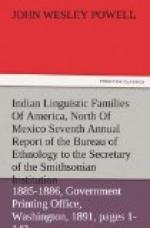> Yatassees, Gallatin in Trans. and Coll.
Am. Antiq. Soc., II, 116,
1836 (the single tribe; said by Dr. Sibley
to be different from any
other; referred to as a family).
> Riccarees, Latham, Nat. Hist.
Man, 344, 1850 (kept distinct from
Pawnee family).
> Washita, Latham in Trans. Philolog.
Soc., Lond., 103, 1856.
Buschmann, Spuren der aztek. Sprache,
441, 1859 (revokes previous
opinion of its distinctness and refers
it to Pawnee family).
> Witchitas, Buschmann, ibid., (same as his Washita).
Derivation: From the Caddo term ka’-ede, signifying “chief” (Gatschet).
The Pawnee and Caddo, now known to be of the same linguistic family, were supposed by Gallatin and by many later writers to be distinct, and accordingly both names appear in the Archaeologia Americana as family designations. Both names are unobjectionable, but as the term Caddo has priority by a few pages preference is given to it.
Gallatin states “that the Caddoes formerly lived 300 miles up Red River but have now moved to a branch of Red River.” He refers to the Nandakoes, the Inies or Tachies, and the Nabedaches as speaking dialects of the Caddo language.
Under Pawnee two tribes were included by Gallatin: The Pawnees proper and the Ricaras. The Pawnee tribes occupied the country on the Platte River adjoining the Loup Fork. The Ricara towns were on the upper Missouri in latitude 46 deg. 30’. The boundaries of the Caddoan family, as at present understood, can best be given under three primary groups, Northern, Middle, and Southern.
Northern group.—This comprises the Arikara or Ree, now confined to a small village (on Fort Berthold Reservation, North Dakota,) which they share with the Mandan and Hidatsa tribes of the Siouan family. The Arikara are the remains of ten different tribes of “Paneas,” who had been driven from their country lower down the Missouri River (near the Ponka habitat in northern Nebraska) by the Dakota. In 1804 they were in three villages, nearer their present location.[21]
[Footnote 21: Lewis, Travels of Lewis and Clarke, 15, 1809.]
According to Omaha tradition, the Arikara were their allies when these two tribes and several others were east of the Mississippi River.[22] Fort Berthold Reservation, their present abode, is in the northwest corner of North Dakota.
[Footnote 22: Dorsey in Am. Naturalist, March, 1886, p. 215.]
Middle group.—This includes the four tribes or villages of Pawnee, the Grand, Republican, Tapage, and Skidi. Dunbar says: “The original hunting ground of the Pawnee extended from the Niobrara,” in Nebraska, “south to the Arkansas, but no definite boundaries can be fixed.” In modern times their villages have been on the Platte River west of Columbus, Nebraska. The Omaha and Oto were sometimes southeast of them near the mouth




